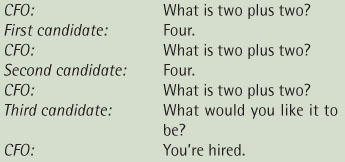Misguided Marketing Major  <a onClick="window.open('/olcweb/cgi/pluginpop.cgi?it=jpg::::/sites/dl/free/0072994029/0073130087_001_1914.jpg','popWin', 'width=NaN,height=NaN,resizable,scrollbars');" href="#"><img valign="absmiddle" height="16" width="16" border="0" src="/olcweb/styles/shared/linkicons/image.gif"> (K)</a> <a onClick="window.open('/olcweb/cgi/pluginpop.cgi?it=jpg::::/sites/dl/free/0072994029/0073130087_001_1914.jpg','popWin', 'width=NaN,height=NaN,resizable,scrollbars');" href="#"><img valign="absmiddle" height="16" width="16" border="0" src="/olcweb/styles/shared/linkicons/image.gif"> (K)</a>
© Chuck Savage/CORBIS
During a class break in your investments class, a marketing major tells the following story to you and some friends: The chief financial officer of a large company is interviewing three candidates for the top accounting position with his firm. He asks each the same question:  <a onClick="window.open('/olcweb/cgi/pluginpop.cgi?it=jpg::::/sites/dl/free/0072994029/0073130087_001_0658.jpg','popWin', 'width=NaN,height=NaN,resizable,scrollbars');" href="#"><img valign="absmiddle" height="16" width="16" border="0" src="/olcweb/styles/shared/linkicons/image.gif"> (K)</a> <a onClick="window.open('/olcweb/cgi/pluginpop.cgi?it=jpg::::/sites/dl/free/0072994029/0073130087_001_0658.jpg','popWin', 'width=NaN,height=NaN,resizable,scrollbars');" href="#"><img valign="absmiddle" height="16" width="16" border="0" src="/olcweb/styles/shared/linkicons/image.gif"> (K)</a>
After you take some good-natured ribbing from the nonaccounting majors, your friend says, “Seriously, though, there must be ways the accounting profession prevents that kind of behavior. Aren’t there some laws, or rules, or something? Are they based on some sort of theory, or are they just arbitrary?” | 
